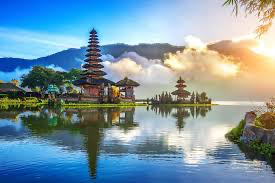Bali Province (Indonesian: Bali), is one of the provinces of Indonesia, and is an international tourist destination. There is a volcanic rock formation in it, which is one of its important features, its name is Tanah Lot, and its capital is Denpasar.
It is considered one of the most famous islands in Indonesia, with a diverse landscape of hills and mountains, rugged coastlines and sandy beaches, fertile rice terraces and barren volcanic hills all provide a stunning backdrop for a colorful, deeply spiritual and unique culture that has made it dubbed Heaven on Earth. With world-class surfing and diving, a plethora of cultural, historical and archaeological attractions, and a huge selection of accommodations, this is one of the most popular island destinations in the world and one that consistently wins awards for most traveled islands.
Bali was inhabited by the Austronesians, who migrated from Taiwan across the sea across Southeast Asia around 2000 BC.
Culturally and linguistically, the people of Bali are closer to the tribes of: the Indonesian archipelago, the Philippines and the Oceania regions. The traditional rock tools found near the village of Sikk in the east of the island are evidence of the cultural rapprochement between these tribes.
The culture of the people of Bali was clearly influenced by the Indian and Chinese cultures, and specifically by the Hindu culture at the beginning of the first century AD.
In the year 991 A.D. he was born in Bali, Arlanga, and he is one of the kings who ruled east Java, while his younger brother Kowali ruled as his representative on the island of Bali. His tomb and the tombs of his wives constitute a group of rock tombs in Tampac Serang surrounded by shelters carved into the rock used to house monks appointed for special religious service. In the royal tombs, in 1343 the Balinese royal family fell at the hands of the Javanese Majahit kingdom, and the center of power moved to Pejing, then to Klongklong, and its ruler was still considered the first place among the other rulers of Bali, even under Dutch rule. The Balinese in stone carving refer to their love of intricate interlocking ornamentation and their tendency to leave no spaces uncarved.
The first European contact with the island was through Dutch explorer Cornelis de Hautman in 1597 AD. Then came Dutch colonization, which included the rest of the islands of the Indonesian archipelago in the nineteenth century
Touristic places
Amed – An area of quiet traditional fishing villages with black sand beaches and coral reefs
Bedugul – beautiful lakes in the mountains, a golf course, botanical gardens and the famous Ulun Danu Bratan Temple
Bukit Peninsula – the southern tip of Bali, with world-class surf, great beaches, and don’t miss the cliff-hanging Uluwatu Temple
Kintamani – active volcano Mount Batur, great mountain scenery, Bali’s largest lake, cooler temperatures Vegetables and fruits
Nusa Dua – high-end resorts and a long golden sandy beach
Nusa Lembongan – for lovers of diving, windsurfing and a great place to relax
West Bali National Park – Bird watching and diving in Bali’s only large nature reserve area
Jet Jet Waterfall – located in the village of Jet Jet in northern Bali
Tegenungan Waterfall – located in the village of Tegenungan and is characterized by the density of surrounding trees and wonderful springs
Sekumpul Falls – a wonderful place divided into 7 rocky steps through which water flows
Champohan Waterfall – also called the Twin Waterfall, is fed by the waters of the Yeh Lambah and Dalim Rivers in Bandung
Bali Safari Park – an open zoo located in the south of Bali
Bird Garden in Bali – It includes about 250 different species of birds, wide green spaces and tropical plants


